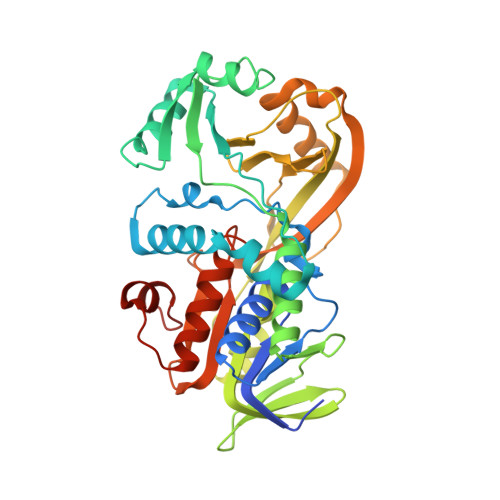Structure-function correlation in glycine oxidase from Bacillus subtilis
Moertl, M., Diederichs, K., Welte, W., Molla, G., Motteran, L., Andriolo, G., Pilone, M.S., Pollegioni, L.(2004) J Biol Chem 279: 29718-29727
- PubMed: 15105420
- DOI: https://doi.org/10.1074/jbc.M401224200
- Primary Citation of Related Structures:
1RYI - PubMed Abstract:
Structure-function relationships of the flavoprotein glycine oxidase (GO), which was recently proposed as the first enzyme in the biosynthesis of thiamine in Bacillus subtilis, has been investigated by a combination of structural and functional studies. The structure of the GO-glycolate complex was determined at 1.8 A, a resolution at which a sketch of the residues involved in FAD binding and in substrate interaction can be depicted. GO can be considered a member of the "amine oxidase" class of flavoproteins, such as d-amino acid oxidase and monomeric sarcosine oxidase. With the obtained model of GO the monomer-monomer interactions can be analyzed in detail, thus explaining the structural basis of the stable tetrameric oligomerization state of GO, which is unique for the GR(2) subfamily of flavooxidases. On the other hand, the three-dimensional structure of GO and the functional experiments do not provide the functional significance of such an oligomerization state; GO does not show an allosteric behavior. The results do not clarify the metabolic role of this enzyme in B. subtilis; the broad substrate specificity of GO cannot be correlated with the inferred function in thiamine biosynthesis, and the structure does not show how GO could interact with ThiS, the following enzyme in thiamine biosynthesis. However, they do let a general catabolic role of this enzyme on primary or secondary amines to be excluded because the expression of GO is not inducible by glycine, sarcosine, or d-alanine as carbon or nitrogen sources.
Organizational Affiliation:
Section of Biology, University of Konstanz, P O Box 5560-M656, Italy.
















